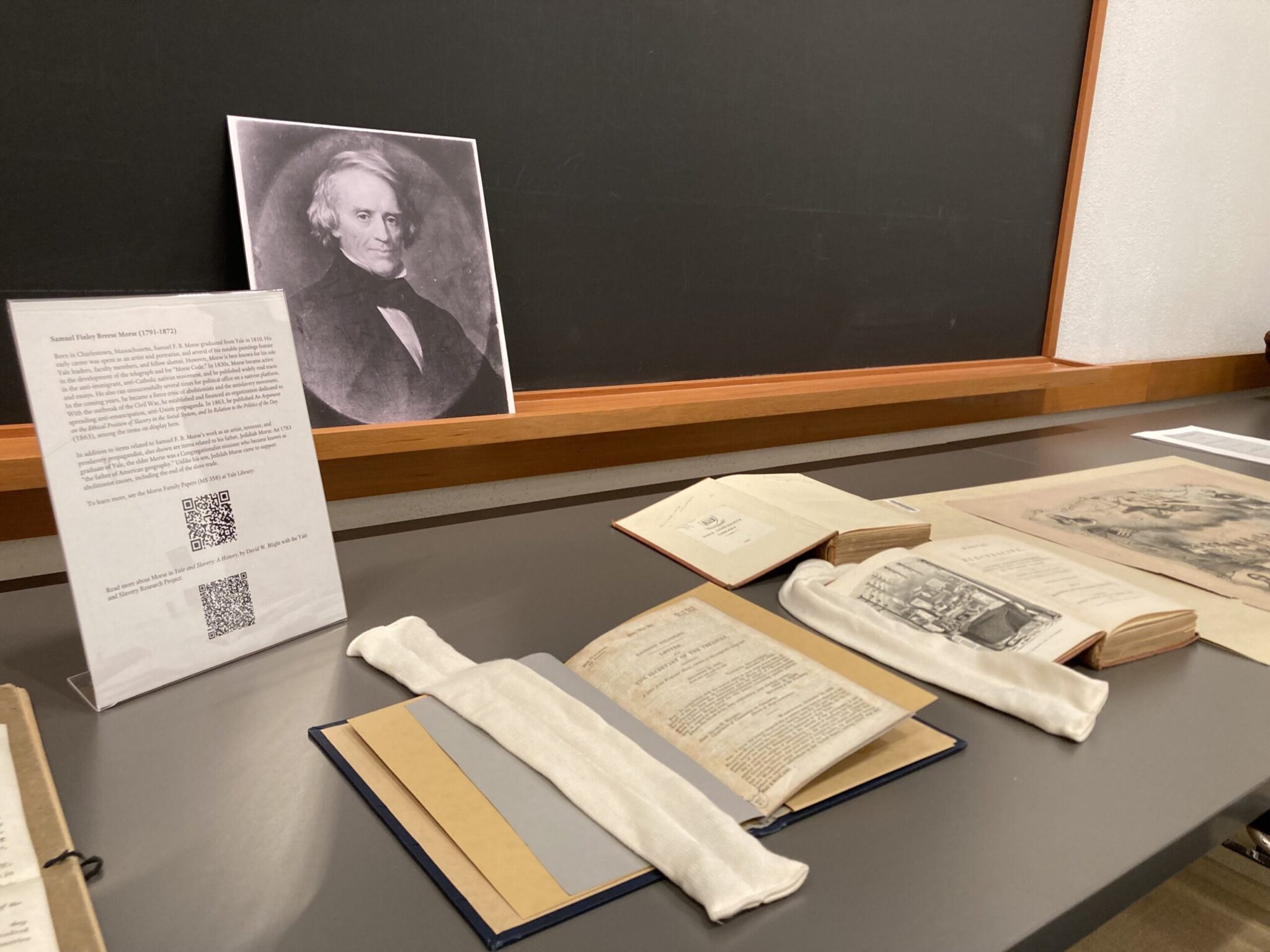Beinecke exhibit reflects on Samuel F. B. Morse’s legacy, Yale and slavery
The Beinecke Rare Book and Manuscript Library held a drop-in session with archival materials on key documents included in the book “Yale and Slavery: A History” and specific items related to Samuel F. B. Morse this week.

Chris Tillen, Contributing Photographer
While Samuel F.B. Morse is known for the invention of the electric telegraph and Morse Code, an exhibit at the Beinecke on Thursday highlighted his white supremacist and anti-immigration beliefs.
The exhibit and documents reflecting Yale’s ties to enslavement were displayed as a part of the Yale Slavery Research Project. The findings of the project were highlighted in a book, “Yale and Slavery: A History,” written by history professor David W. Blight with the Yale Slavery Research Project.
The book discusses Morse’s legacy, as a scientist, inventor and painter who vehemently opposed abolition, immigration and Catholicism. A graduate of Yale College in 1810, Morse published a book in 1863 that defended enslavement.
The exhibit was arranged by Michael Morand ’87 DIV ’93, director of community engagement at the Beinecke, and Hope McGrath, lead researcher of the Yale and Slavery Research group and the Beinecke research coordinator for Yale, New Haven and Connecticut history.
“Actually seeing the physical evidence tells you something and convinces you of its reality and power in ways that can only be done when you’re with materials in the archives,” Morand said.
Inspired by a discussion with Head of Morse College Catherine Panter-Brick and Assistant Director of Operations Alexa Martindale, the Beinecke compiled artifacts from Morse’s life to be viewed by community members. Morse College hosted an unveiling of the new book on Feb. 16.
While this is the first event focused on residential college namesakes, other residential colleges are currently planning to hold future exhibitions discussing the legacies of their namesake’s history.
Morand said that the exhibit places Morse in the context of his father, Jedidiah Morse, a man who is known for his contributions to American geography, and played a role in Yale and New Haven’s ties to slavery. The exhibit included a table chronicling the history of Yale’s ties to slavery and a separate table on Jedidah and Samuel Morse. The Morse part of the exhibit included maps drawn by Jedidah and writings and artistic pieces from Samuel’s life, including his writing in opposition to abolition that he published in 1863.
McGrath said that the first part of the exhibit was intended to show the influence and role of enslaved people in Yale’s history. The exhibit began with the 1701 charter for the founding of Yale as the Collegiate School of Connecticut, and the table continued to illustrate growth in Black community building in New Haven through Black political resistance.
The exhibit draws specific attention to the proposal for the first Black college in New Haven in 1831, a proposal that was shot down by the leadership of Yale and New Haven.
Morand said that this exhibit is one aspect of the larger movement to confront Yale’s past truthfully. He said that Blight and the Yale Slavery Research Project’s published book is another aspect, along with new audio added to Yale walking tours and “Shining Light on Truth,” an exhibit at the New Haven Museum that features the essential history of enslaved and free Black people in New Haven’s history.
Martindale added that seeing these items in person “drives home” the history. Panter-Brick described the group experience of viewing and reading archival material surrounded by fellow community members as “shocking” and “sobering.”
Panter-Brick also spoke about the importance of including New Haveners, not just students and Yale community members, in these conversations.
“It’s a broader issue than what’s happened here on our grounds,” Martindale said.
Martindale and Panter-Brick said that residential college leaders gathered a task force to brainstorm specific responses for their colleges following the book’s release in February. This led to Panter-Brick reaching out to Beinecke administrators about doing a curated exhibit.
Morand said that he hopes the exhibit will serve as a jumping-off point for history, where learning about Morse is an “access point” into a larger story about Yale, New Haven, America and the world.
“It’ll be truly a success if [attendees] go away, wanting to know more and thinking about how they can write the history and understand the history of themselves,” said Morand.
Karim Najjar ’27, who is in Morse and visited the exhibit, told the News that it made him reflect the importance of understanding the meaning of Morse’s name.
“Eating lunch under Morse’s name each day, I believe it is critically important to understand what the name has meant over time,” Najar wrote to the news.
Ai-Li Hollander ’27, another student in Morse, said she appreciated the opportunity to learn about Yale’s history and gain collective community knowledge.
On why he chose to attend the exhibit, Manav Singh ’25, who is in Morse, echoed the other Morse students in emphasizing the significance of knowing their college’s history.
Panter-Brick added that while this was the first exhibit on Morse’s legacy, it will not be the last.
“It’s not the last session at all, I will very happily take another group of people, for example, first-year students next year … so they’re also grounded in that history,” said Panter-Brick.
The Beinecke is hosting a session on “New Haven, Yale and Slavery in the Archives” with the Greater New Haven African American Historical Society on Sunday, March 17.







